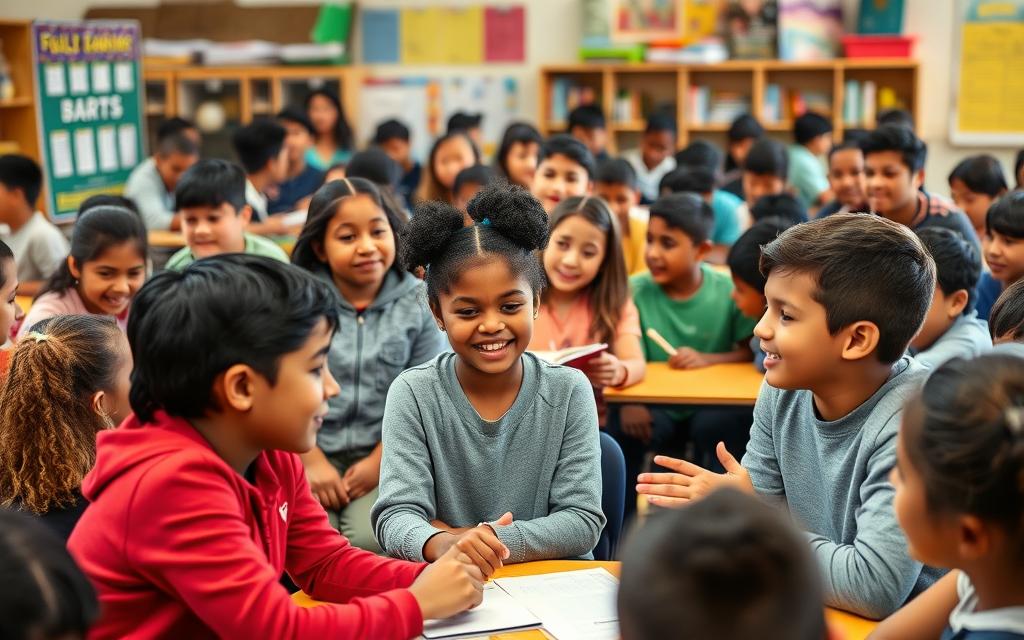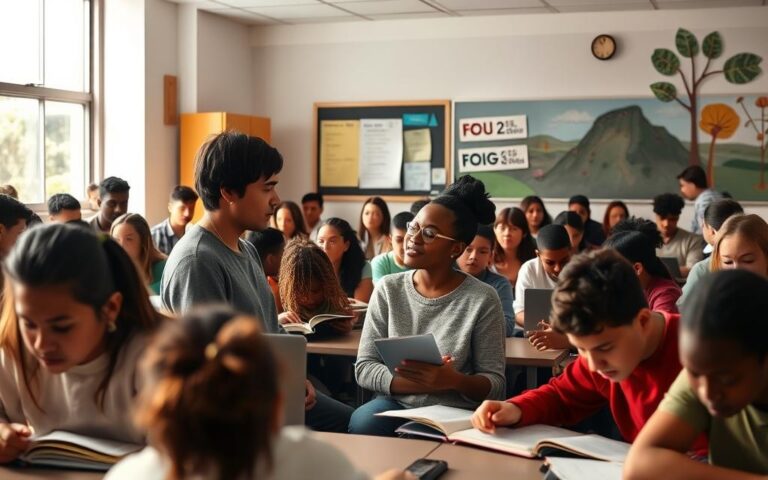adversiment
Bilingual education in U.S. classrooms teaches content in two languages. This helps build skills and biliteracy. Districts like Los Angeles and Boston see more students in dual language programs.
These programs mix structured lessons with culturally responsive teaching. This approach is chosen by educators and families.
Studies show bilingual learning improves thinking, cultural awareness, and academic performance. It also boosts social skills and offers long-term economic benefits. Quality biliteracy programs use regular checks, specific language goals, and materials that match students’ backgrounds.
This article is for teachers, school leaders, parents, and policymakers interested in bilingual education. It covers what bilingual education is, its benefits, strategies, challenges, success stories, and trends.
Understanding Bilingual Education
Bilingual education teaches in two languages to improve language skills. It aims for additive bilingualism, keeping the student’s first language while adding a second. Some programs focus on subtractive methods, moving students away from their first language.
Teachers aim for biliteracy, which means reading and writing in both languages. This is different from just speaking.
Definition and Scope
Learning a second language goes through stages from pre-production to advanced fluency. Classrooms use input, interaction, and scaffolding to help learners. Researchers like Jim Cummins talk about a Common Underlying Proficiency that connects language skills.
Stephen Krashen’s input hypothesis emphasizes the importance of meaningful exposure. These ideas help create curricula that support biliteracy and academic growth.
Key Types of Bilingual Programs
Transitional bilingual education starts with the student’s home language, then shifts to English. Critics worry that support ending too soon can lead to losing the home language.
Developmental or maintenance bilingual programs support both languages for a long time. They aim to deliver academic content in each language.
Dual language instruction comes in 50:50 and 90:10 formats. The 50:50 model balances time between languages. The 90:10 model gives more early instruction in the partner language, then moves toward parity.
Both forms of language immersion programs help native and non-native speakers gain skills and cultural knowledge.
Two-way bilingual programs mix native speakers of both languages in one classroom. Content-based ESL and sheltered instruction provide alternatives for English learners in mainstream settings. They embed language goals within subject teaching.
Choosing a program depends on many factors. These include student demographics, community language goals, staffing, curriculum resources, and assessment strategies. Thoughtful planning ensures bilingual education meets local needs.
Enhancing Cognitive Skills
Bilingual learners see big gains in skills like attention, memory, and quick thinking. Studies show bilingual education boosts these abilities. It helps with tasks that need focus, memory, and fast rule changes.
Improved Problem-Solving Abilities
Switching languages makes the mind better at adapting. This boosts problem-solving skills. Harvard and the University of Toronto found bilingual students do better in puzzles and tests.
Using both languages in class helps solve problems. Try puzzles, projects, or design challenges. These activities improve thinking and keep students interested.
Boosted Critical Thinking Skills
Working with texts in two languages helps understand language better. This boosts critical thinking. Bilingual students often compare views, spot biases, and ask deeper questions.
Strategies like reading comparisons, translation, and debates in both languages help. They encourage deeper thinking and analysis. This moves learners from just understanding to higher thinking.
Cultural Awareness and Sensitivity
Bilingual learning does more than teach words. It opens doors to various histories, rituals, and ways of life. Schools that focus on multicultural education make classrooms welcoming. Here, students feel valued for their languages and traditions.
Fostering Inclusivity
When schools honor students’ native languages, it boosts their confidence. Teachers choose books that mirror students’ backgrounds. Family language nights let caregivers share stories and songs, strengthening the bond between school and home.
Programs based on Gloria Ladson-Billings and Geneva Gay’s work focus on culturally relevant teaching. Classrooms that celebrate diversity see better attendance and a stronger sense of belonging.
Promoting Global Citizenship
Dual language instruction prepares students for a world where understanding different cultures is key. Projects that connect with schools abroad teach important skills like negotiation and empathy. Students learn to consider views from various countries and communities.
Curricula that aim for global competence guide teachers in creating tasks that enhance intercultural communication. This shows bilingual education not only improves language skills but also fosters cultural awareness. It prepares students for civic and workplace roles.
Academic Performance Improvement
Students in strong biliteracy programs often show steady gains across subjects. Research from dual immersion districts in California and Utah finds gains in math, reading, and writing. This is compared with peers in one-language models. Early home-language support links closely to later school success.
Language Proficiency Correlations
Proficiency in a first language predicts quicker mastery of a second language. Children who maintain Spanish at home, for example, tend to develop stronger English reading and writing skills. This pattern highlights clear language proficiency correlations that educators can measure and support.
Formative tools such as ACCESS for ELLs and WIDA standards help track progress in both languages. Regular progress monitoring gives teachers data to adjust instruction and target gaps without penalizing temporary lags on English-only tests.
Positive Effects on Standardized Tests
Many meta-analyses and district case studies report that dual immersion students match or outperform monolingual peers on standardized test outcomes by upper elementary grades. Gains appear in English-language arts and mathematics as students build metalinguistic awareness and cross-language vocabulary.
Assessment practices that include accommodations or bilingual testing produce a fairer picture of student knowledge. Schools that combine formative checks with appropriate accommodations can better capture true learning in biliteracy programs.
| Measure | Findings | Practical Action |
|---|---|---|
| First-language proficiency | Strong predictor of second-language literacy growth | Support home language; integrate heritage texts |
| ACCESS for ELLs / WIDA | Useful for tracking dual-language growth over time | Use data to guide instruction and interventions |
| Standardized test outcomes | Dual immersion students often catch up or exceed peers | Provide accommodations; assess bilingual competencies |
| Metalinguistic skills | Transfer to content learning in math and literacy | Include explicit language-analysis lessons |
Social Skills Development
Bilingual classrooms play a big role in teaching social skills. Students learn to see things from different perspectives and communicate clearly. They also develop empathy through daily interactions.

Building Relationships Across Cultures
In bilingual classrooms, students share their cultures and stories. This helps break down barriers and builds true friendships.
Studies show that learning with peers from other languages increases tolerance. Activities like cultural presentations and family events provide learning opportunities.
Teachers can pair students in groups to foster curiosity about different traditions. This creates a classroom where everyone respects each other’s backgrounds.
Encouraging Collaboration in Diverse Groups
Bilingual projects teach students to work together and solve problems. Activities like paired language tasks and peer tutoring improve teamwork.
Using routines like think-pair-share in both languages helps students learn to listen and agree. These skills are essential for working well together.
Students develop strong support networks and a better classroom atmosphere. These skills are valuable in school, neighborhoods, and future jobs.
Economic and Career Advantages
The United States is becoming more linguistically diverse. This opens up economic opportunities for students who learn two languages. Schools connect classroom learning to real-world jobs, showing how language skills lead to stable, rewarding careers.
Job Market Demand for Bilingual Individuals
More job postings now list bilingual skills as a requirement. Industries like healthcare, education, technology, and government need staff who can communicate in multiple languages. The U.S. Bureau of Labor Statistics and private job analyses show a rise in bilingual job opportunities.
Hospitals and community health centers hire interpreters and bilingual clinicians to improve patient outcomes. School districts recruit bilingual teachers for multilingual classrooms. Tech firms hire localization specialists to adapt products for global users. Public agencies need staff for immigration and community outreach work.
Increased Earning Potential
Research shows bilingual employees often earn more. Some studies show modest increases, while others document substantial boosts. Bilingual workers qualify for specialized roles that offer higher pay and faster promotion paths.
Long-term career mobility improves with language skills. Multinational corporations, federal agencies, and non-governmental organizations value employees who can manage cross-border teams and client relationships. Schools can strengthen students’ prospects by pairing language study with career and technical education and with partnerships from local employers.
Promoting bilingual skills careers builds pipelines from the classroom to the workforce. Clear pathways help students pursue certifications, internships, and credentials that align with market demand for bilingual individuals. This creates practical returns on investment for families and communities, while supporting local employers who need language-capable talent.
Challenges in Implementing Bilingual Education
Starting bilingual programs can be tough. Schools face many hurdles like not enough money, not enough teachers, unclear rules, and mixed community support. It’s also hard to measure how well students are learning in two languages.
Here are key areas that need attention to keep bilingual programs strong.
Resource Allocation and Funding
Creating a good bilingual program costs a lot. You need books, online tools, tests, and money for teachers and to attract them. Starting can be expensive because you might need to change materials for two languages.
There are ways to get help, like federal funds, state grants, local bonds, and partnerships. But, getting money for the long term is hard. Schools need a steady plan to make sure all schools get what they need.
Teacher Training and Support
Many schools struggle to find teachers who speak two languages. To fix this, you need programs to train teachers, like bilingual endorsements or alternative certifications.
Teachers also need help to teach subjects like math and science in a second language. They can use special teaching methods and get support from other teachers. This support is key to success.
| Challenge | Typical Cost or Need | Practical Solutions |
|---|---|---|
| Curriculum development | Purchasing/adapting bilingual curriculum, assessments | Use district consortia, adopt shared resources, phase rollouts |
| Staffing | Recruitment incentives, higher salaries for endorsements | Partner with universities, offer tuition reimbursement, alternative certification |
| Professional development | Ongoing coaching and workshops | Leverage ACTFL and WIDA models, peer coaching, release time |
| Funding stability | Short-term grants vs. recurring budgets | Blend federal, state, and local funds; build community partnerships |
| Equity | Uneven resource distribution across schools | Target funds to high-need schools, transparent resource allocation bilingual programs |
| Policy and credentialing | State-by-state variation in requirements | Advocate for consistent standards; update district hiring practices |
Fixing these problems takes time and strong leadership. Having clear plans for money, hiring, and training is a good start.
Best Practices for Bilingual Classrooms
Strong bilingual programs need clear models, aligned standards, and regular checks on student progress. Teachers link language goals with content objectives. They use formative assessment to guide their teaching. Family and community involvement are key to student success.
Effective Curriculum Design
Begin with backward design to ensure mastery in both languages. Use WIDA standards and bilingual materials aligned with Common Core to set learning goals.
Make sure language and content goals are clear. Create lessons that start with support and move to independent work.
Include activities that help students use their language skills in different ways. Use paired reading and thematic units in both languages. Also, integrate writing across subjects.
For classrooms with students at different levels, offer leveled texts and small-group tasks. Use assessments in both languages to track progress. This helps teachers adjust their teaching as needed.
Integrating Technology in Teaching
Choose digital tools that enhance classroom learning. Use Duolingo for Schools and Rosetta Stone Classroom for focused practice. Try Achieve3000 and Raz-Kids for adaptive literacy in various languages.
Use Zoom and Flipgrid for real-time exchanges and authentic communication. Screencastify and Google Forms are great for quick checks with multilingual prompts.
Provide translation tools and access to content from PBS Kids and BBC to enrich cultural learning. Train teachers to pick culturally fitting resources. Ensure all students have equal access to devices and the internet.
Success Stories in Bilingual Education
Schools in the U.S. see real benefits from bilingual programs. This section shares examples and the secrets behind their success. You’ll learn about program features, research partnerships, and family feedback that shows how students grow.
Pioneering programs have a few key things in common. They have strong support from the district, a long-term focus on bilingual education, and training for teachers. Schools in Dallas and New York City have seen better reading and math scores thanks to these efforts.
Working with universities is also important. Schools like Portland Public Schools have seen improvements in reading and math. This is thanks to research and training from places like Stanford School of Education.
Pioneering Schools and Programs
Success comes from long-term planning, community involvement, and support for families. Schools that offer bilingual workshops and cultural events see more families involved in bilingual programs.
Testimonials from Students and Parents
Students and parents talk about feeling more confident and proud of their culture. They also say they feel more connected to school. Parents appreciate being able to help with homework and school events in their native language.
Effective strategies include bilingual parent nights and peer mentor programs. These efforts help families feel welcome and support the bilingual curriculum.
School leaders often mention the importance of social-emotional growth. Parents see their children grow in confidence and resilience. Teachers say this helps students stay engaged and do well in school.
Future Trends in Bilingual Education
Bilingual education is changing with new research, policies, and technology. Schools in California, Texas, and New York are adding more bilingual programs. This is because parents and employers want students ready for the global job market.
These changes mean we’re moving away from just testing in one language. We’re now valuing cultural skills as much as academic ones.
Innovations in Teaching Approaches
New teaching methods focus on using all languages in learning. This includes Content and Language Integrated Learning (CLIL) and project-based learning. Students get to use their full language skills.
Assessments are changing too. We’re using performance tasks, bilingual portfolios, and digital tests that adapt to each student. Technology is also becoming more important. It includes AI, virtual exchanges, and VR for better language and cultural learning.
Predictions for Bilingual Education in the U.S.
Dual language programs will keep growing, and more teachers will be trained. More states will support bilingual education with funding and policies. But, there will still be challenges like keeping funding and ensuring fairness.
Despite these, the trend is positive. It shows that with community support and evidence-based education, bilingual programs will improve. This will help students succeed in a global world.
Educators, families, and leaders should keep up with new teaching methods. They should support research and adapt successful ideas to their schools. This will make bilingual education even better in the U.S.



